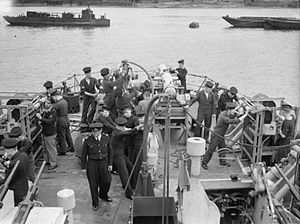This article includes a list of general references, but it lacks sufficient corresponding inline citations. (March 2011) |

Foxer was the code name for a British-built acoustic decoy used to confuse German acoustic homing torpedoes like the G7 torpedo during the Second World War. A US version codenamed FXR was deployed at the end of September 1943 on all transatlantic escort vessels.[1] A Canadian version was also built called the CAAT (Canadian Anti-Acoustic Torpedo) device.[2][3][4][5] It was later replaced in US service by the Fanfare noisemaker.
The device consisted of one or two noise-making devices towed several hundred metres astern of the ship. The noise makers mechanically generated a far louder cavitation noise than the ship's propellers. This noise decoyed the acoustic torpedoes away from the rear of the ship into a circling pattern around the noise maker (which was too small to strike) until the torpedo ran out of fuel. The noisy Foxer had the disadvantage that it also prevented the ship's own ASDIC from detecting any other U-boat nearby that could approach the convoy.[6]
Nevertheless, the FXR countermeasure proved to be highly effective in decoying German acoustic torpedoes. Of the approximately 700 G7es torpedoes fired, only about 77 hit their target.[7]
- ^ Morison 2002, p. 146.
- ^ "Science and technology in the Second World War" (PDF). Canada Remembers. Veterans Affairs Canada. Retrieved 16 February 2022.
- ^ "ReadyAyeReady.com - The Canadian Navy". readyayeready.com. Retrieved 2020-08-12.
- ^ "GNATs versus CATs | Legion Magazine". legionmagazine.com. Archived from the original on 2022-01-18. Retrieved 2020-08-12.
- ^ Navy, Royal Canadian (2018-04-30). "The Battle of the Atlantic, 1939 to 1945". aem. Retrieved 2020-08-12.
- ^ Williamson 2012, p. 45.
- ^ Showell 2009, p. 52.